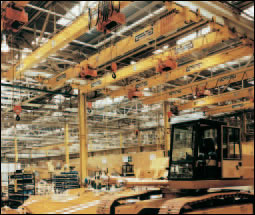
Matterson M20’s - at KOMATSU plant
LIFTING UNIT CLASSIFICATION
Matterson hoists and crabs are designed to BS.466:1984 standards which facilitates the ready selection of the most economic lifting unit from a serialised range of products based upon lifting capacity and anticipated duty of the equipment. Knowing the safe working load and range of lift required the next stage in choosing the correct hoist for any application is to establish its Group Classification for which two factors are required:
CLASS OF UTILISATION
1) Average time the lifting unit will be in operation. By referring to Table A the class of Utilisation ‘T’ can be obtained against the average utilisation time.
Table A
| Class of Utilisation |
Assumed average daily Utilisation time (hours) |
Service life of hoist (hours) |
|---|---|---|
| T1 | ≤ 0.25 | 400 |
| T2 | >0.25 and ≤ 0.5 | 800 |
| T3 | >0.5 and ≤ 1 | 1600 |
| T4 | >1 and ≤ 2 | 3200 |
| T5 | >2 and ≤ 4 | 6400 |
| T6 | >4 and ≤ 8 | 12500 |
| T7 | >8 and ≤ 16 | 25000 |
| T8 | >16 | 50000 |
| T9 | >16 | >50000 |
STATE OF LOADING
2) Type of duty on which the uplifting unit will be employed. From Table B select the most appropriate type of duty and determine the State of Loading ‘L’.
Table B
| State of Loading | Type of duty |
|---|---|
| L1 | Hoists subjected very rarely to their maximum load and normally to very light loads. |
| L2 | Hoists occasionally subjected to their maximum load but normally to rather light loads. |
| L3 | Hoists frequently subjected to their maximum load but normally loads of medium magnitude. |
| L4 | Hoists regularly subjected to their maximum loads. |
B.S GROUP CLASSIFICATION
3) With the two factors from Tables A and B the British Standard Classification ‘M’ of the lifting unit can be determined from table C.
Table C
| State of Loading (Table B) |
Class of Utilisation (Table A) | ||||||||
|---|---|---|---|---|---|---|---|---|---|
| T1 | T3 | T3 | T4 | T5 | T6 | T7 | T8 | T9 | |
| L1 | M3 | M3 | M3 | M3 | M4 | M5 | M6 | M7 | M8 |
| L2 | M3 | M3 | M3 | M4 | M5 | M6 | M7 | M8 | M8 |
| L3 | M3 | M3 | M4 | M5 | M6 | M7 | M8 | M8 | M8 |
| L4 | M3 | M4 | M5 | M6 | M7 | M8 | M8 | M8 | M8 |
| Duty class to F.E.M. standards |
| Corresponding to 1.S.O. standards |
| Average daily operating time in hours |
≤05 | ≤1 | ≤2 | ≤4 | ≤8 | ≤16 | |||||||||
|---|---|---|---|---|---|---|---|---|---|---|---|---|---|---|---|
| Class of Duty | V0,25 | T2 | V0,5 | T3 | V1 | T4 | V3 | T6 | V3 | T6 | V4 | T7 | |||
| type of service |
1 | L1 | Light | 1Bm | M3 | 1Am | M4 | 2 m | M5 | 3 m | M6 | ||||
| 2 | L2 | Medium | 1Bm | M3 | 1Am | M4 | 2 m | M5 | 3 m | M6 | |||||
| 3 | L3 | Heavy | 1Bm | M3 | 1Am | M4 | 2 m | M5 | 3 m | M6 | |||||
| 4 | L4 | Very Heavy | 1Am | M4 | 2 m | M5 | 3 m | M6 | |||||||
| GROUP | 1Bm | M3 | 1Am | M4 | 2 m | M5 | 3 m | M6 | |||||||
| Duty factor * | 25% | 30% | 40% | 50% | |||||||||||
| No of starts per hour | 150 | 180 | 240 | 300 | |||||||||||
![]()
Illustrations and specifications may be changed without notice and are intended for guidance only. Please consult us for current product details.


